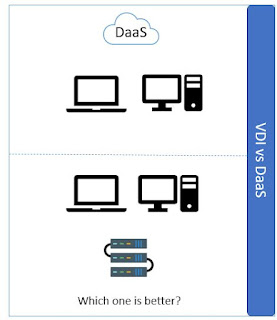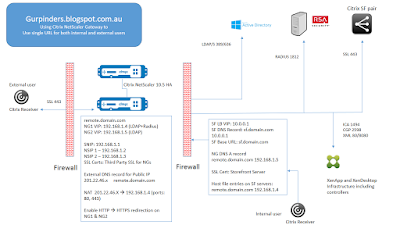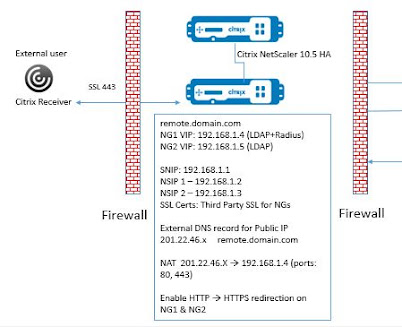It has changed a lot since my last post in 2015 on VDI vs DaaS. The wind has totally changed now and many organizations have already made a move to DaaS platforms or thinking of moving. COVID-19 has changed the picture about remote working and many organizations have invested their time and money to strategize their remote working journey.
Citrix Cloud has evolved over last 5 years, Microsoft Azure Virtual Desktop (aka AVD) has been launched since we last discussed about VDI vs DaaS along with their new DaaS offering called Windows 365 (which is similar to AWS workspaces). VMWare is not far behind with latest advancements and feature-rich suite of Horizon Cloud (VMware DaaS).
Many Organizations are re-evaluating their current dying VDI infrastructure and planning a move to a better DaaS product. Before you make a switch, we need to understand:
What DaaS offer?
What are the considerations?
And choosing the right product.
DaaS has many benefits over VDI and some of them are listed below.
DaaS Benefits:
1) Simplification: DaaS decouples the Control Infrastructure responsibilities to the service provider, allowing customers to focus more on their core business. Organizations can save time and effort for their internal IT teams required to patch, update and do hardware maintenance of their control infrastructure.
2) Scalability and flexibility: When compared to VDI, DaaS is more scalable and flexible. Virtual desktops can be added or removed by organizations without a lot of infrastructure design or expense. DaaS is the perfect choice for enterprises with varying user needs or seasonal workloads because of its agility.
3) Accessibility: DaaS is a great choice for remote work, branch offices, and mobile staff because users can access their virtual desktops from any location with an internet connection. Having the freedom to work from any device improves productivity and teamwork.
Some Considerations on DaaS:
1) Downtime & SLAs: Organizations that choose DaaS rely on the service provider to guarantee the performance and availability of the virtual desktop infrastructure. To reduce downtime and guarantee data security, it's critical to select a recognized supplier with a solid infrastructure and dependable service level agreements (SLAs).
2) Security & Compliance: Another key aspect is to carefully evaluate the security measures implemented by the DaaS provider. It must comply with the organization's data encryption, access control and regulatory compliance requirements.
3) Connectivity: Moving away from VDI to DaaS changes the way how user connect to the virtual desktops. DaaS relies on stable high-speed internet connection instead of MPLS/S2S VPN links. Slow internet connection can lead to latency issues or disruptions in accessing their virtual desktops. So, organization must get some decent internet links for office-based users.
VDI or DaaS Selection:
Based on the specific needs of your organization, a number of variables need to be taken into account when choosing between VDI and DaaS:
1) Infrastructure & IT Skills: Always analyze your company's infrastructure resources and capabilities. DaaS does help you with taking away the need to maintain the control infrastructure, but it still relies on stable internet connection for your end users. On the other hand, VDI would need organization to make some upfront investments in software, hardware and IT skills.
When making a switch from VDI to DaaS product, we need to be mindful about the necessary skills required if we are switching the technology. For example, it might be easier for IT teams to manage and support end users if they are switching from On-Prem Citrix to Citrix DaaS compared with switching to AVD/VMware Horizon which would mean that they might need some new skills now.
2) Scalability and Flexibility: Consider your organization's needs for scalability as well as its capacity to manage changing user demands. Compared to VDI, DaaS is more flexible and scalable, making it simpler to change the number of virtual desktops as needed. VDI may call for more infrastructure design and deployment work.
3) Security and compliance: Consider both the VDI and DaaS systems' security precautions and compliance capabilities. Choose the option that best complies with the compliance norms and security requirements of your organization.
4) Cost Management: Budgetary considerations Costs connected with VDI and DaaS should be compared. VDI requires an upfront financial investment for IT resources, infrastructure, and maintenance, whereas DaaS often has a subscription-based pricing model. Analyse each option's long-term costs and return on investment.
The decision between VDI and DaaS ultimately comes down to the unique requirements, financial constraints, and organizational priorities of your company. It is advised to carefully compare the two options, take future expansion strategies into account, and even investigate hybrid models that mix on-premises VDI with cloud-based DaaS. Engaging with IT experts, consulting with service providers, and running test projects can all offer insightful information that will aid in your decision-making.




